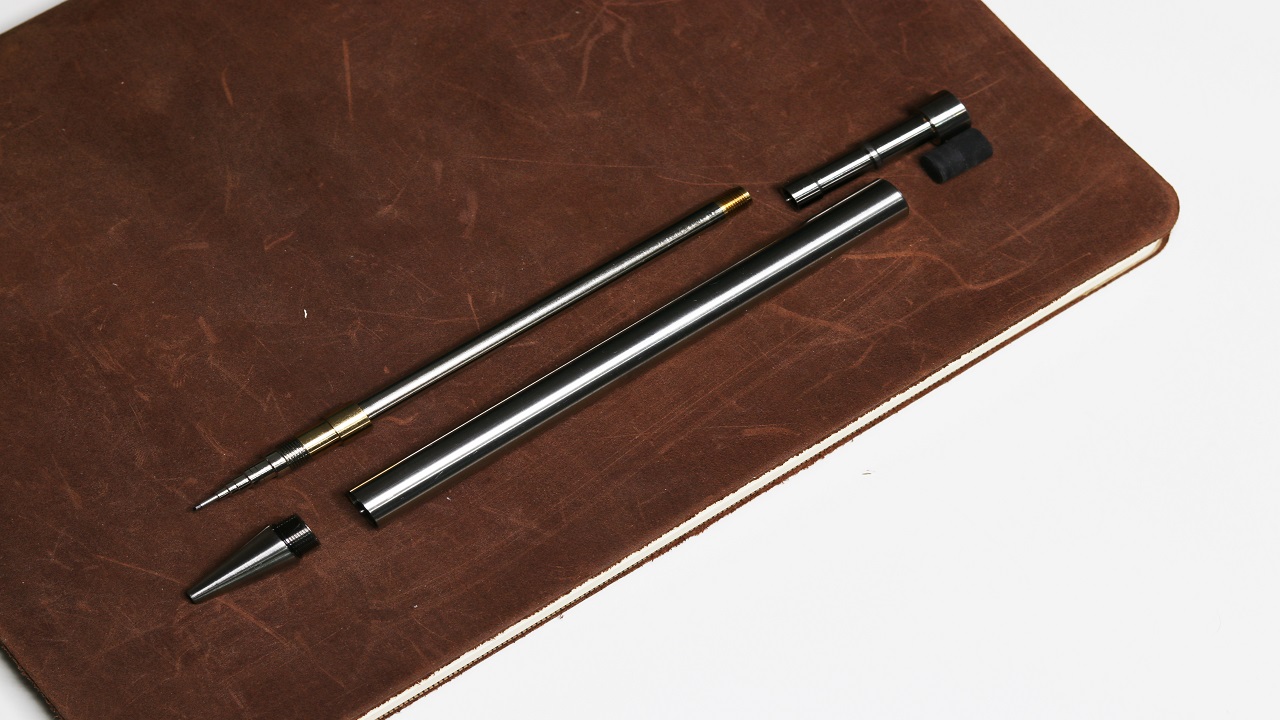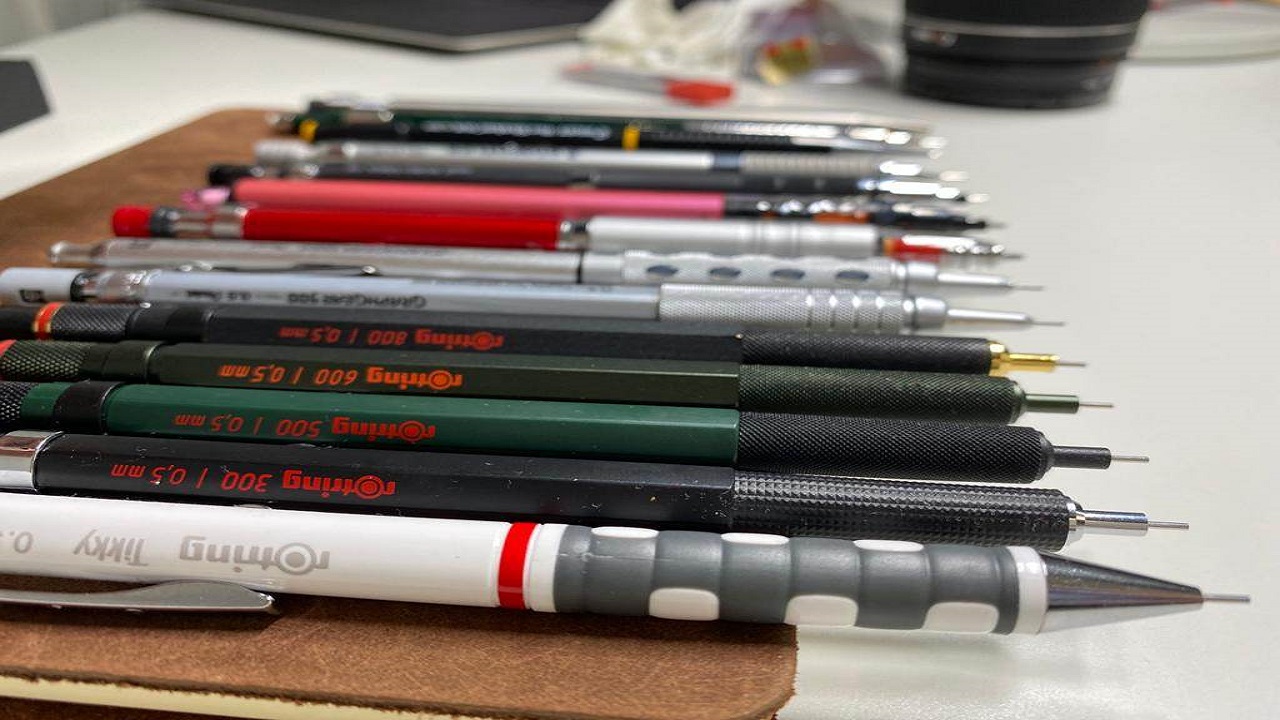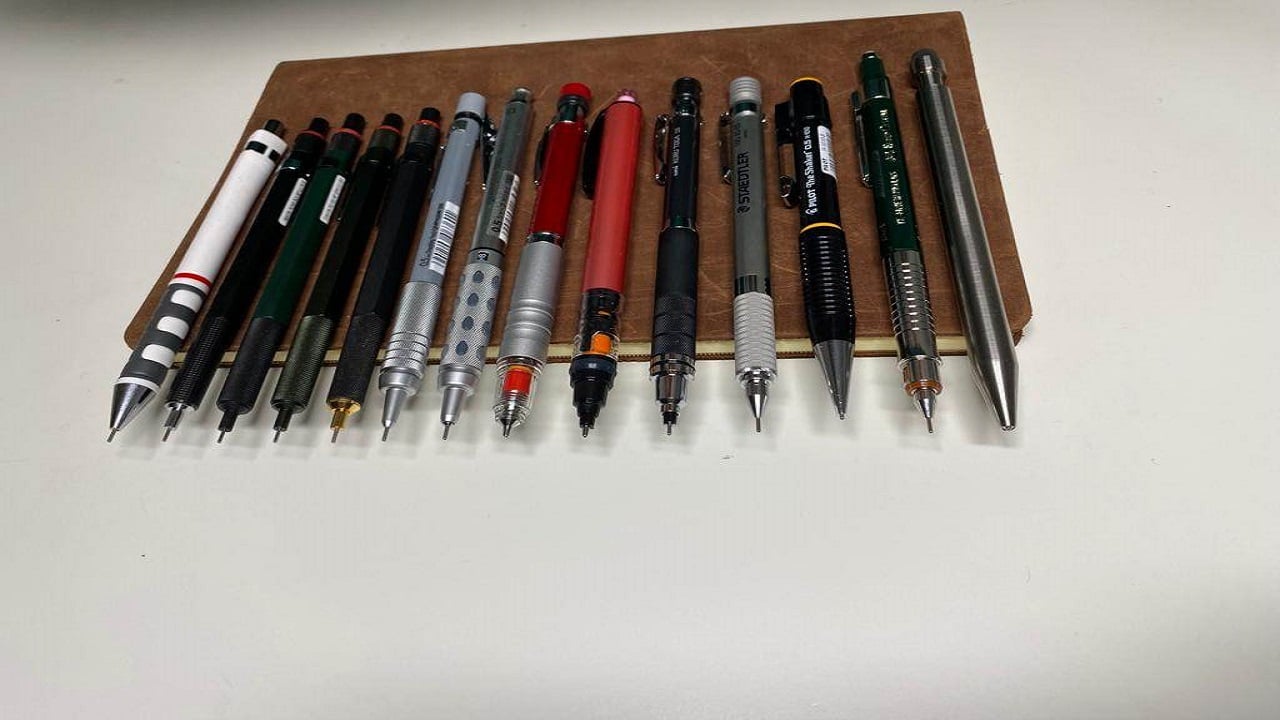If you know mechanical pencils, you’d know that they have varying lead sizes. However, a large number of people still need to be made aware of the different sizes of mechanical pencil leads available and each of their specific uses.
So, I have made an extensive comparative list where specifics about each pencil lead size are mentioned in detail as well as when it can be used. Let’s take a look.
0.2 Mm – 0.4 Mm: The Thinnest Pencil Leads

Very fine leads that range from 0.2 mm to 0.4 mm are the most popular choice for writing in smaller spaces and to do precise detail work. Ideally, people who write relatively smaller characters use a mechanical pencil with this particular pencil lead size.
But since the leads are small and thin, they are extremely fragile. So, using them with mechanical pencils that have lead-protecting properties would be the ideal thing to do.
1. 0.2 mm
A 0.2 mm mechanical pencil is the thinnest pencil lead among all mechanical pencil leads. It is the most commonly used pencil lead for the most precise details and compact equations. This tiny lead allowed me to write easily in all tight-knit spaces like margins or planner squares.
However, since these mechanical pencil leads are extremely thin, they are also fragile. Hence, they must be used with a light hand and utmost care to eliminate the possibility of the lead breaking off.
2. 0.3 mm
0.3 mm mechanical pencil leads are the slightly bigger versions of 0.2 mm leads, but they are still pretty small and much more easily available. They are also much smoother and stronger, making them a great option for people who prefer a fine mechanical pencil lead but dislike fragile ones.
3. 0.4 mm
0.4 leads are not the most popular choice for writing, but they can be a good in-between size. Since 0.5 was too big for me, I decided to opt for the 0.4 lead instead, because I still needed the durability of a 0.5 lead. The 0.4 mm mechanical pencil lead is slightly less precise when compared to the 0.3 mm leads but much more durable.
Typically, these leads are picked up by artists and drafters, who like to work with something much more durable. Most mechanical pencils do tend to skip the 0.4 lead, so you’ll have to depend on a drafting pencil to experiment with this mechanical pencil lead size.
0.5mm – 0.7 mm: All Purpose Mechanical Pencil Leads
Their respective writing styles are the main contrast between 0.5 mm and 0.7 mm leads. Both the leads are compact enough to write readable writing in various sizes and strong enough to withstand the average writing pressure without breaking.
Both the mechanical pencil lead sizes are equally suitable for various drawing needs, like technical drawings and sketching. Heavy-handed writers, or those who have a more prominent handwriting, frequently use 0.7 mm leads due to their durability and sturdiness. On the other hand, light-handed writers use the smaller pencil lead size of 0.5 mm.
1. 0.5 mm
This mechanical pencil lead size provides the right balance between precision and sturdiness, which works quite well for most people. Hence, it doesn’t come as a surprise that the 0.5 mm lead size is a widely used mechanical pencil lead, suitable for various writing and drawing tasks.
2. 0.7 mm
Since I like the precision of the 0.5 mm lead but want something more sturdy, I decided to give 0.7 mm a try. These pencil leads are the ideal choice for writers with heavy hands and people with a more prominent handwriting. They also produce slightly smoother and softer marks than 0.5 mm leads.
0.9 mm – 1.3 mm: Thicker Mechanical Pencil Leads

These leads are quite uncommon and are meant specifically for people who write or draw with a heavy hand or need to make strong and bold sketches. They are much smoother than the smaller-sized leads because of the wider tips that do not dig into the paper.
These leads are also buildable, which allows an artist to create more tonal variations by applying different pressures.
1. 0.9 mm
Out of all the wide pencil leads, 0.9 mm lead is the most common. They help make thick lines and are very convenient to use, as they easily glide on the paper.
These leads are also very durable, which helped me extend the mechanical pencil lead further to write with, and at the same time, they did not break off easily. This allows the artist to write or draw for longer without having to pause to extend the pencil lead over and over again.
Note
Some brands manufacture a 1 mm lead size, which is generally the same as 0.9 mm leads. If you’re unable to find 0.9 mm leads, you can easily substitute them with a 1 mm pencil lead.
2. 1.1 mm – 1.18 mm
The mechanical pencil lead sizes 1.1 mm, 1.15 mm, and 1.18 mm are all equal in their diameter. These leads are often limited to vintage-inspired mechanical pencils that have a twist lead extension mechanism. And a few leads of these sizes are almost as long as the regular pencil leads. However, these unique leads are meant to be used in specific pencils such as the Autopoint Jumbo and E+M Move.
But the majority of the pencils will not be able to use up all of the pencil lead, leading to some wastage. I solved this issue by replacing regular leads with shorter ones, which allowed me to use them up fully. However, since the leads were short, I had to replace them frequently.
3. 1:3 mm
1.3 mm is the largest pencil lead size in the category of exclusive mechanical pencil leads. They produce broad lines that are extremely smooth and consistent. These leads are ideal for sweeping, loose movements for intense sketching sessions or casual doodling.
2 mm – 3.2 mm: Standard Lead Holder Leads
Mechanical pencils with 2 mm leads or above are known as lead holders. These thick leads are often used to give extra support to graphite soft lead and colored leads that break very easily.
Like traditional wooden pencils, these pencils can have their leads sharpened to manipulate the width of the line. They usually have specialized sharpeners known as lead pointers that allow you to sharpen them and other tools such as sandpaper and knives.
Another significant difference between a lead holder pencil and a typical mechanical pencil is its lead advancement system. Lead holders usually use a drop clutch advancement mechanism, whereas mechanical pencils use the incremental lead advancement mechanism for gently pushing the lead. Lead holder pencils with clutch mechanism are also known as clutch pencils.
1. 2 mm
2 mm is a commonly used lead holder size that closely mimics the lead used in traditional wooden or woodcase pencils. These leads are usually sharpened for precise detailed drawing and used at a specific angle for most gesture work as well as for shading any large areas, with several lead grades available for this particular size.
Since I like the versatility of wooden pencils but prefer heavier and longer pencils, a 2 mm lead holder is one my favorites.
2. 3.15 mm – 3.2 mm
The 3.15 mm and 3.2 mm lead sizes are interchangeable since they are pretty similar in several aspects. They have slightly higher coverage than the 2 mm leads but can still be sharpened to achieve a more precise tip.
Since the lead holder pencils suitable for these sizes are extremely durable, they can be used with leads on the softer side that would otherwise break under high pressure. These lead holders pencils are also interchangeable, and either of the leads can be switched for the other with no issue.

4 mm – 5.6 mm: Large Lead Holder Leads
These lead sizes are extra wide and can be used to make various lines with varying widths depending on the angle used and how sharp the point is. They are usually the best leads for making wide strokes and shading.
Since they are quite durable, they allow the artist to apply more pressure when drawing without the pencil leads being prone to breakage. This makes them a great choice for large-degree tonal variations.
1. 4 mm
The 4 mm leads are visibly larger than the 3.15 mm and 3.2 mm leads. Ideally, they can be used for sketching out quick rough ideas and clearing any blank space. And almost all 4 mm leads available on the market fall under the smooth B-grade leads.
2. 5.2 mm – 5.6 mm
The 5.2 mm and 5.6 mm leads are among the broadest leads typically used for creating bold lines or to quickly cover large spaces. However, they can be sharpened to a point that allows them to create surprisingly fine details.
The three main sizes that belong to this group are interchangeable regarding usage but only partially when it comes to their specific lead holders. I found out that larger lead holders could accommodate smaller sized leads without a problem, but the smaller holders couldn’t do the same with larger leads.

How To Choose The Right Lead?
Now that I’ve mentioned all the mechanical pencil lead sizes available on the market, let’s look at the factors that will help you choose the correct lead for your needs.
A. The Right Lead Diameter
This measurement is usually mentioned either on the mechanical pencil or its clip. Different mechanical pencils require different leads of a specific lead thickness. A 0.3 mm lead diameter will be ideal for an artist who wants to draw extremely precise details, but it may not be very suitable for regular writing.
On the other hand, the 0.5 mm lead diameter is the most commonly used lead for writing and drawing. Overall, it is the most versatile lead size and perfect for everyday use.
However, a 0.7 mm lead diameter will be suitable for times when you want to create broader lines with little to no regard for precision. Since these leads are on the thicker side, they are ideal for long-hand drafting or for use in a drafting pencil.
A 0.9 mm lead is a much thicker lead when compared to the 0.7 mm lead, and its lead holder can be used with softer leads. They are commonly used for slow writing like solving puzzles or sudoku.
B. Using Specialty Sizes
Out of the mechanical pencil lead sizes mentioned above, some sizes, like 5.6 mm, fall in between. This specialty size lead (2 mm and up) requires sharpening and often comes with its designated sharpener. Ideally, it is used by artists who have specific requirements and need leads of a certain size.
C. Determining Lead Hardness
Softer leads are much darker than other types. The softer the lead, the thicker the line it draws on paper. However, it is also more smudge prone.
Harder leads, on the other hand, leave behind lighter marks and are much finer. The most common lead hardness ratings are medium-grade HB and H, with 9H being the hardest and H being the softest. And the lead hardness can be selected depending on what you’re using the mechanical pencil for.
D. The Writing Style
One main factor I had to consider while choosing the right lead was whether it fit my writing style. Light-handed writers tend to depend on lighter or fine-point leads, as they won’t need much pressure. But for writings or drawings that require high pressure, medium-thickness leads will work well.
Why Should You Choose A Mechanical Pencil Over A Traditional Wooden Pencil?
Wooden and mechanical pencils are the most commonly used types of pencils. I agree that wooden pencils are, in fact, fully sustainable and disposable. However, a sharpener is always needed to use a wooden pencil. When a wooden pencil is being sharpened, a piece of the writing tool is constantly being shaved away.
This makes the pencil shorter and shorter until it is too uncomfortable to be used. Besides, wooden pencils are always a safety hazard due to their pointy lead being exposed constantly without a pencil cap or a pocket protector.
Mechanical pencils, on the other hand, can write almost forever as long as the lead is replaced. Though lead replacement can be a bothersome task, it still is much better when compared to constantly sharpening a wooden pencil, only for it to lose its point in a couple of uses. Moreover, all mechanical pencils with leads under 0.7 mm can draw a consistent line without needing to be sharpened.
Unlike the wooden pencil, the mechanical pencil leads are used up almost fully until the pencil cannot hold the graphite any longer, after which the leads need to be replaced. They are also much easier on the pockets and do not pose a safety threat because they can retract the mechanical pencil lead into the pencil after use.
However, some mechanical pencils can face the problem of a lead jam. This is when bits and pieces of lead get lodged within the pencil, causing a jam and making it hard to use. In such cases, knowing how to fix a mechanical pencil, and what tools to use, can help significantly. Keeping tools like a clean-out rod handy, will be beneficial in maintaining the pencil as well as increasing its lifespan.
How To Choose The Right Mechanical Pencil?
As you may have figured out, one of the main criteria of choosing a mechanical pencil is the lead size it’s compatible with. Generally, I suggest sticking to the 0.5 mm or 0.7 mm pencils. Since they are the most common size of mechanical pencils, you can easily find a replacement if you run out of your existing lead.
Another factor that is important while choosing the best mechanical pencil is the pencil grip. Most mechanical pencils do come with a soft, rubbery grip that allows the user’s hand to sit comfortably.
For example, Rotring pencils, which are among the top mechanical pencils, almost always come with knurled grips. As a result, they can be written with for longer periods of time without any cramps or dents on the fingers.
A few other optional things I considered while buying a mechanical pencil are the lead grade/size indicators and lead advance mechanism. Since I own a large collection of mechanical pencils, the lead grade/size indicator helps me significantly to sort them out.
The lead advancement mechanism is the way in which a mechanical pencil advances lead from the barrel to the tip of the pencil. Some common advancement mechanisms are button, shake, or a twist mechanism. The twisting mechanism is very common in vintage mechanical pencils but not much in modern mechanical pencils, as they need to be twisted several times for the lead to advance to the tip.
A shake mechanism pencil is a fun one to own, as shaking the mechanical pencil up and down causes a tiny amount of weight on the inside of the mechanical pencil. And this, in turn, leads to the advancement of the mechanical pencil lead.

Mechanical Pencil Lead Size Conclusion
Leads for mechanical pencils come in various sizes, and it can get pretty overwhelming to choose from so many options. I hope my comprehensive guide on mechanical pencil sizes helped you choose the right one for your needs.
If you’re still confused, I suggest that you try experimenting with various sizes till you find the one that best suits your style. Well, they say art is all about experimenting, who say art supplies aren’t?
On that note, it’s time for me to wrap up. If you like reading this informative article, check out my other article titled ‘types of home office desks.’
See you again!



